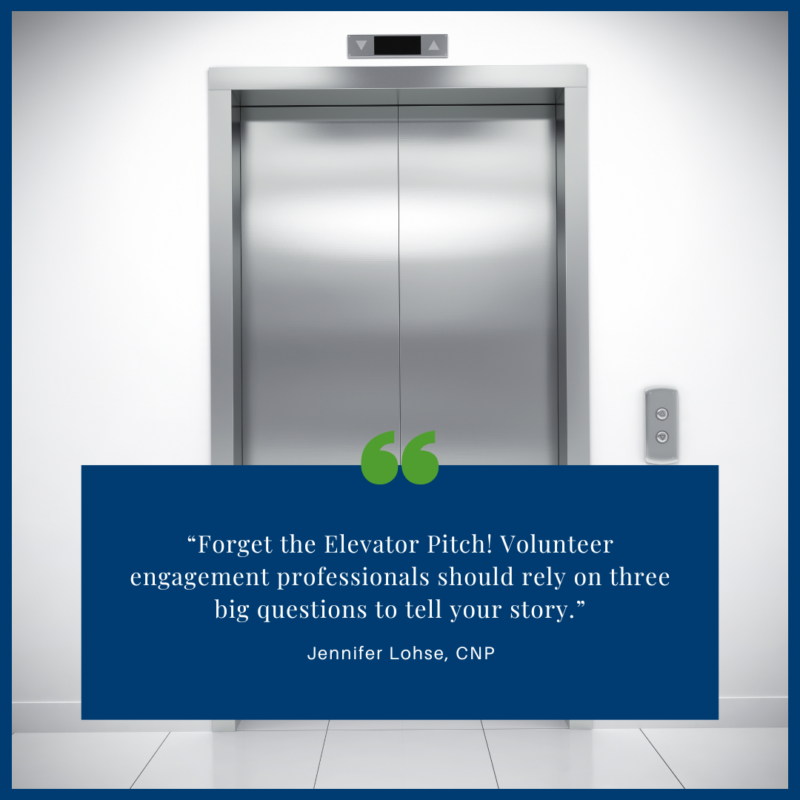Forget the Elevator Pitch
Forget the elevator pitch, volunteer engagement professionals should rely on three big questions to tell your story. Before we get straight to the questions, let’s be clear, the pitch does offer a helpful crafting concept that we shouldn’t disregard. So we should start with the concept for those that are not familiar.
The pitch concept, goes something like this…I’m a nonprofit employee/founder and I jump on an elevator. I am joined by a billionaire who seeing my name tag says, “I see you are with XYZ nonprofit, tell me about it.” Nothing short of an Oscar worthy performance occurs in that 30 second elevator ride. Did I convince my companion to pull out his checkbook before the end of the ride?
Even with a fresh take on the concept…swap elevator to Starbucks line, and checkbook to Zelle…it still isn’t working for us. Partly because what we are “pitching” is three distinct things to many different audiences, and we are doing it with a “choose your own adventure” ending. So I say again…
Forget the elevator pitch, use the Big Three Questions
The big three questions for volunteer engagement professionals.
- What problem is your organization solving for whom, and where?
- How does your organization solve this problem?
- How can someone help solve the problem?
What is the problem your organization is trying to solve?
This is a big one, let’s break it down. That is Geography……..Demographics………Problem Statement…..
Let’s try a few of SAVMA’s member organizations and see how we do:
- Southern Arizona youth age six (6) through high school graduation experience adversity and risky behaviors because of a lack of positive relationships, educational support and exposure to high aspirations.
- Patients suffering from life-limiting illnesses need medical end of life care even if it requires pain management, and no matter where the patient may reside, no matter their immigration status, nor their income status.
- Research by the Federal Reserve Bank of New York shows only 27 percent of college graduates say they work in a field with their degree. Only 25 percent of Americans say the are in their dream job. Both of these facts are contributing to “quiet quitting” statistics and wage inflation from the great resignation.
None of these are particularly clear, but without diving into the research myself this is what I pulled from their homepages. Can you guess which organizations are solving these problems? You should be able to do better for your own organization if you have research on the problem demographic.
How does your organization solve the problem?
While the question looks simple, I’ve learned as a professional philanthropist, organizations often complicate matters here. As Volunteer Engagement Professionals, let’s keep it simple:
- Cradle to Career Partnership Pima aligns the contributions of businesses, school districts, community leaders, philanthropists, and social sector leaders together to take effective action that is complementary, mutually supportive, and leveraged to produce measurable improvement resulting in a livable and sustainable wage for a family.
- Housing nonprofits work to reduce the proportion of families that spend more than 30 percent of income on housing.
- Delivering nutritious, and medically tailored meals to people in Southern Arizona through a network of caring individuals.
How can someone help solve the problem?
This is your sweet spot dear Volunteer Engagement Professional. You love asking this question. You are a match maker and this is your time to shine. Turn to the person across from you and ask them, in any variety of ways if they can see themselves being connected with solving the problem? Do you have the right volunteer position for them? Are they more of a check writing type? Time, talent or treasure right?
However, if your organization is not their thing be sure you are listening carefully for the handoff clues. If someone isn’t interested in your organization, bless and release them to a peer. That is a different post all together.


Leave A Comment
You must be logged in to post a comment.